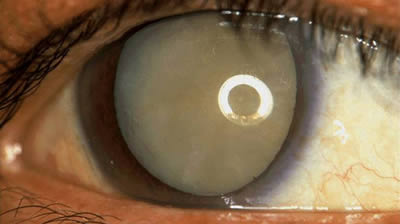Cataracts are one of the most common eye problems in the world. By age 70, over half of Americans will develop a cataract in one or both eyes. Cataracts can make it difficult to read, drive, watch television, or recognize faces. Over time, cataracts that are left untreated can result in permanent blindness.
Laser cataract surgery is the most effective method for cataract removal. The simple procedure can restore vision that was lost to cataracts and in some cases, improve vision beyond the patient’s original prescription.
Keep reading to learn more about cataracts and your options for laser cataract surgery in Columbus, OH.
A cataract is a cloudy group of proteins that form in the lens of the eye. The lens is made from naturally transparent tissue and is located directly behind the iris, the colored part of the eye.
The lens helps to focus light and images on your retina, which results in clear vision.

As we age, proteins in the lens start to clump together and form a cataract.
Over time, cataracts can get progressively worse and affect the quality of your vision — this can result in blurry or hazy eyesight, similar to looking through a fogged-up window.
Cataracts most frequently occur in individuals over age 40, but it’s possible to develop cataracts at any age.
The primary symptoms of cataracts include blurry or cloudy vision, sensitivity to light, excessive glare or halos around lights, and poor night vision. Colors may also appear less vibrant and you may see double in one eye.
As a general rule, if you’re 40 or older, you’re at increased risk for cataracts. Additional risk factors for cataracts include:
Unfortunately, there is no scientific proof that shows you can prevent cataracts from forming. There are,however, steps you can take to reduce your risk.
First and foremost, it’s important to schedule regular eye exams. Early detection is the best way to ensure you don’t lose your vision to cataracts, as your doctor can monitor cataract progress and recommend treatment as needed.
Try to schedule an eye exam at least once a year — the sooner you are diagnosed, the easier it is to prevent serious vision loss.
If you have a health condition such as glaucoma or diabetes, however, your doctor may recommend more frequent eye exams to monitor the health of your eyes.
Cataract surgery is a very common, simple procedure. It’s offered exclusively as an outpatient surgery, which means you don’t have to stay in the hospital after surgery.
The procedure takes approximately thirty minutes from start to finish — in fact, you may spend more time in the waiting room and recovery area than you will in surgery!

Cataract surgery is performed in a few short steps:
Once the IOL is inserted, the procedure is over. The incision is small enough that no stitches are necessary to close it. Since the eye heals quickly on its own, the incision will close naturally over time.
IOLs come in several different varieties. In general, you can choose between a standard or premium IOL for cataract surgery.
Also referred to as “monofocal” IOLs, standard IOLs are basic, single vision IOLs that are fully covered by Medicare and most other types of health insurance.
Monofocal lenses are fixed-focus, which means they only focus at one distance — near, intermediate, or far. If you choose a monofocal IOL to correct near vision, you’ll need glasses to improve your distance vision, and vice versa.
Premium multifocal IOLs are designed to allow you to see clearly at near, intermediate, and far distances. In contrast to standard monofocal IOLs, 85% of patients who receive multifocal IOLs find that they do not need to wear glasses for distance or up-close activities after cataract surgery.
Since premium cataract lenses have more advanced features than standard IOLs, they typically incur more out-of-pocket costs.
Many patients, however, place a higher value on premium IOLs due to the increased quality of life after cataract surgery.
Not every patient who has cataracts needs surgery for them. While cataract surgery is the only viable option for cataract removal, some cataracts do not require treatment.
It can take years for cataracts to develop and reach the point where they impede vision, so it’s possible for a cataract diagnosis to require no action from the patient at all.
Consistent eye exams are the best way for your doctor to monitor cataract progression and eventually, determine whether or not you are a candidate for cataract surgery.
If your cataracts have progressed to the point where they affect daily activities such as reading, driving a car, or using a computer, it may be time to consider cataract surgery.
Laser cataract surgery is the most modern and effective method to restore vision loss from cataracts. At Mid Ohio Eye Physicians and Surgeons, we use the latest technology to provide the best possible surgical outcome.